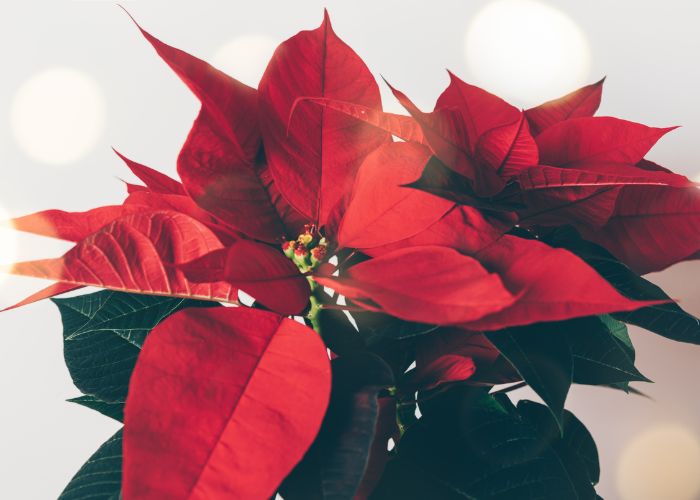How to Care for a Poinsettia
Discover the best care tips for poinsettias, from watering frequency to post-Christmas care. Learn about poinsettias' potential toxicity to cats. We will also share the secrets of maintaining vibrant and healthy poinsettias throughout the year.Enhance your festive decor with poinsettias from Rosies and Posies. Plus, enjoy the convenience of delivery to Santa Clara County. Brighten your space with these iconic holiday plants!

Festive Elegance: Poinsettia Care Tips, Cat Safety, and Exclusive Tips
Native to Mexico, poinsettia belongs to the Euphorbiaceae family and is a very popular holiday staple. The bright bracts are prized and are often mistaken for flower petals. Although poinsettias are often associated with winter celebrations, they retain their appeal as attractive houseplants year-round.
As winter days get shorter, poinsettias undergo a fascinating transformation. The actual flower of a poinsettia consists of petal-like bracts and a small yellow central flower known as a siatia. These colorful bracts play an important role in attracting insects for pollination and eventually fall off once the process is complete.
The holiday season brings poinsettias in a variety of colors to match different decorating themes.
From the classic creamy whites and pinks to the iconic bright reds, these plants display attractive patterns in striking shades such as red and white, pink and white, or green and white, and sometimes bright orange.
Poinsettias also come in a variety of flower shapes, some of which resemble roses. Sometimes, you may also find unconventional colors such as blue or purple, achieved by spray painting cream-colored varieties. Sometimes these painted poinsettias are decorated with glitter to add a festive sparkle.
How to Care for a Poinsettia
Light and Temperature for Poinsettias
For optimal growth, place the plant indoors with bright natural light, preferably in a south, east, or west-facing window. If placed outdoors, make sure your poinsettia receives about 4 to 6 hours of partial sunlight each day.
For best results, maintain internal temperature between 65 and 70 °F. Avoid areas where temperatures can fluctuate or become dry, such as: B.
Proximity to cold air, heat ducts, fireplaces, fans, space heaters, and similar sources. Poinsettias are sensitive to cold temperatures and temperatures below 50 degrees Fahrenheit can cause damage. It is important to protect your poinsettia from freezing temperatures, as these temperatures can be detrimental to its health.
How Often to Water Poinsettia
Maintain soil moisture by watering the plant when the soil surface feels dry to a gentle touch or the pot feels light when lifted. Prevent poinsettias from becoming so dry that they wilt. Before watering, remove the decorative foil or outer pot, and ensure the plant is in a well-draining container. Place the plant in a sink, water it thoroughly, and allow for complete drainage. Avoid letting poinsettia pots stand in excess water, as prolonged wetness can lead to the rotting of plant roots.
Fertilizing Poinsettias
There is no need to fertilize poinsettias during the holiday season. Start fertilizing your plant as soon as you notice new growth, such as fresh green leaves, stems, and bracts. Use an all-purpose plant fertilizer and mix it with water at half the recommended concentration. Feed your poinsettia every three to four weeks to ensure your plant gets the nutrients it needs to stay healthy and continue producing new growth.
Transplanting
In late spring or early summer, move your poinsettia to a larger container about 2 to 4 inches larger than its original pot, or plant it in a flower bed in a partially sunny garden.
For potted plants, use a soil mix rich in organic matter. Apply peat moss and make sure the new pot has good drainage.
For garden beds, choose well-drained soil that receives 4 to 5 hours of sunlight each day. Mixing organic matter such as peat moss or compost into the soil increases moisture retention and creates the perfect environment for root growth.
Water your poinsettia thoroughly after transplanting.
What to do with Poinsettias after Christmas
A common question is, "How can I get my poinsettia to bloom again?" Poinsettias can be grown as attractive houseplants, but many people want to bring back the vibrant color of green poinsettias, especially for the holiday season.
Achieving this change is a difficult process that requires blocking light from the plant for a specific period while maintaining overall plant health. This reduction in light inhibits the production of chlorophyll, the pigment responsible for the green color of plant parts. Depending on the type of poinsettia, this changes the color of the bracts to red, pink, or white.
Are Poinsettias Poisonous to Cats?
Poinsettias in particular do not affect the health of animals or humans, but it is important to avoid ingesting them. Poinsettia's white sticky sap can cause skin rashes. Therefore, it is important to wear gloves when handling these plants. Be careful not to touch your eyes or mouth, and wash the tools you use to clean them thoroughly to prevent the sap from getting sticky.
As you enjoy caring for your poinsettias, why not explore the beautiful collection at Rosies and Posies? Elevate your holiday spirit with our handpicked varieties, guaranteed to add festive cheer to your home. We deliver to Santa Clara County, bringing the holiday magic directly to you. Embrace the beauty of poinsettias and make your season brighter. We wish you joy and a wonderful shopping experience at Rosies and Posies!
Recent Posts
Year : 2024
Year : 2023
Year : 2021
Year : 2020

